
Thomas Carlyle was a Scottish essayist, historian, and philosopher from the Scottish Lowlands. A leading writer of the Victorian era, he exerted a profound influence on 19th-century art, literature, and philosophy.

Chelsea is an affluent area in West London, England, due south-west of Charing Cross by approximately 2.5 miles (4 km). It lies on the north bank of the River Thames and for postal purposes is part of the south-western postal area.

Cheyne Walk is a historic road in Chelsea, London, England, in the Royal Borough of Kensington and Chelsea. It runs parallel with the River Thames. Before the construction of Chelsea Embankment reduced the width of the Thames here, it fronted the river along its whole length.
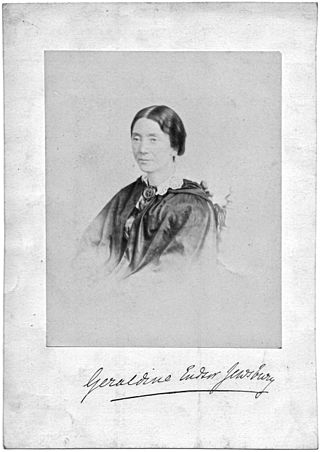
Geraldine Endsor Jewsbury was an English novelist, book reviewer and literary figure in London, best known for popular novels such as Zoe: the History of Two Lives and reviews for the literary periodical the Athenaeum. Jewsbury never married, but enjoyed intimate friendships, notably with Jane Carlyle, wife of the essayist Thomas Carlyle. Jewsbury's romantic feelings for her and the complexity of their relations appear in Jewsbury's writings. She tried unsuccessfully to encourage her close friend Walter Mantell to start a new life as an author after his disagreement with the New Zealand government over Maori land rights.

Fors Clavigera: Letters to the Workmen and Labourers of Great Britain was the name given by John Ruskin to a series of letters addressed to British workmen during the 1870s. They were published in the form of pamphlets. The letters formed part of Ruskin's interest in moral intervention in the social issues of the day on the model of his mentor Thomas Carlyle.

Craigenputtock is an estate in Scotland where Thomas Carlyle lived from 1828 to 1834. He wrote several of his early works there, including Sartor Resartus.

The French Revolution: A History was written by the Scottish essayist, historian and philosopher Thomas Carlyle. The three-volume work, first published in 1837, charts the course of the French Revolution from 1789 to the height of the Reign of Terror (1793–94) and culminates in 1795. A massive undertaking which draws together a wide variety of sources, Carlyle's history—despite the unusual style in which it is written—is considered to be an authoritative account of the early course of the Revolution.

Past and Present is a book by the Scottish essayist, historian and philosopher Thomas Carlyle. It was published in April 1843 in England and the following month in the United States. It combines medieval history with criticism of 19th-century British society. Carlyle wrote it in seven weeks as a respite from the harassing labor of writing Oliver Cromwell's Letters and Speeches. He was inspired by the recently published Chronicles of the Abbey of Saint Edmund's Bury, which had been written by Jocelin of Brakelond at the close of the 12th century. This account of a medieval monastery had taken Carlyle's fancy, and he drew upon it in order to contrast the monks' reverence for work and heroism with the sham leadership of his own day.

Jane Baillie Carlyle was a Scottish writer and the wife of Thomas Carlyle.
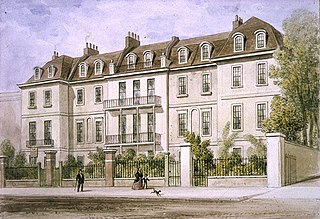
Lindsey House is a Grade II* listed villa in Cheyne Walk, Chelsea, London. It is owned by the National Trust but tenanted and only open by special arrangement.
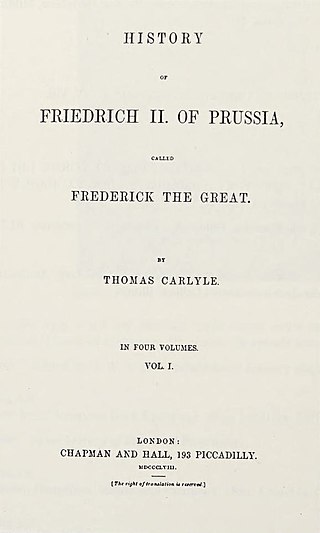
History of Friedrich II. of Prussia, Called Frederick the Great is a biography of Friedrich II of Prussia by Scottish essayist, historian and philosopher Thomas Carlyle. It was first published in six volumes from 1858 to 1865.
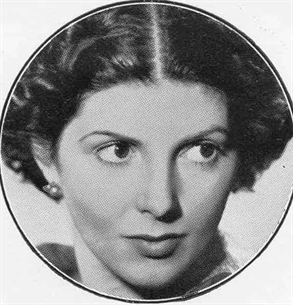
Thea Holme was a British actress and writer.

The Church of Our Most Holy Redeemer and St Thomas More, also referred to as Holy Redeemer Church, is a Roman Catholic Parish church in Chelsea, London. it was built in the 19th century and opened on 23 October 1895. It was designed by Edward Goldie. It is situated on the corner of Upper Cheyne Row and Cheyne Row, next to Carlyle's House in the Royal Borough of Kensington and Chelsea. It is listed Grade II on the National Heritage List for England.

Cheyne Row is a residential street in Chelsea, London.
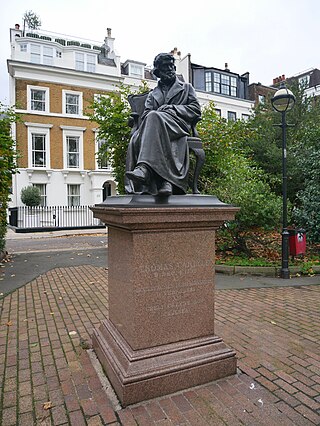
A statue of Thomas Carlyle by Joseph Edgar Boehm stands in Chelsea Embankment Gardens in London. Erected in 1881 and unveiled in 1882, it stands close to 24 Cheyne Row where Carlyle lived for the last 47 years of his life. The statue became a Grade II listed building on 15 April 1969.
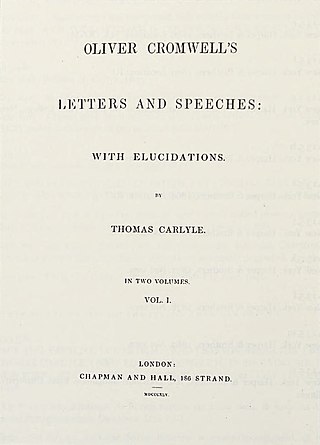
Oliver Cromwell's Letters and Speeches: with Elucidations is a book by the Scottish essayist, historian and philosopher Thomas Carlyle. It "remains one of the most important works of British history published in the nineteenth and twentieth centuries."

The Carlyle–Emerson correspondence is a series of letters written between Thomas Carlyle (1795–1881) and Ralph Waldo Emerson (1803–1882) from 14 May 1834 to 20 June 1873. It has been called "one of the classic documents of nineteenth-century literature."

Thomas Carlyle's house, Comely Bank is a Category B listed building in Edinburgh, Scotland. It was once the home of Scottish essayist, historian and philosopher Thomas Carlyle. He lived there with his wife Jane Carlyle from October 1826, the time of their marriage, to May 1828, when they moved to Craigenputtock.

Scotsbrig is a farm near Ecclefechan, Dumfries and Galloway, Scotland, and a Category B listed building. Thomas Carlyle lived there with his family in the summer of 1826 before moving to 21 Comely Bank, Edinburgh. Scotsbrig remained a residence of the Carlyle family for decades. The farmhouse underwent numerous additions and renovations in the eighteenth and nineteenth centuries.






















